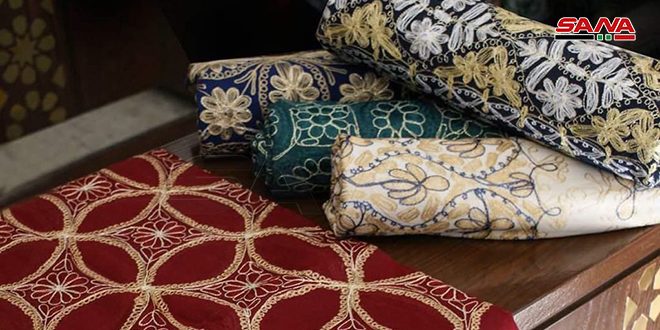Damascus, ST– The Damascene craftsmen from the time of the Phoenicians till our days, have created the most beautiful embroideries, as the white and wool cloth embroidered with gold and silver threads was very famous in the city of Damascus more than 500 years ago. This kind of craft is called al-Aghabani.
 Hisham al-Noqtah, one of the ancient professionals in the craft of Al-Aghabani, and one of the few who still have a workshop to manufacture it and display it in the shops of Medhat Pasha Market, said that Al-Aghbani is a pure handcraft made of natural silk, gold and reed threads and embroidered by needle with embossed embroideries. This distinguishes Al-Aghbani from other Damascene fabrics, such as brocade and silk.
Hisham al-Noqtah, one of the ancient professionals in the craft of Al-Aghabani, and one of the few who still have a workshop to manufacture it and display it in the shops of Medhat Pasha Market, said that Al-Aghbani is a pure handcraft made of natural silk, gold and reed threads and embroidered by needle with embossed embroideries. This distinguishes Al-Aghbani from other Damascene fabrics, such as brocade and silk.
Al-Aghbani is also distinguished by its seven colors and the names of its drawings, where each embroidered stitch has a special name such as ” Saqf al- Qa’a”, ” Daqqat al-Lira”, “Al-Sultan”, and “Lam Alef'” drawing that was embroidered on the turbans which were worn by the dignitaries and scholars of Damascus. Al-Noqta also pointed out that the every piece of Aghabani needs about a month to be completed, so the Damascene families had to wait a long time to complete the bedspreads and clothes.
 AL-Noqta told SANA that he inherited this craft from his grandparents. He designs drawings and engravings on cloth that is either silk or cotton, then begins the stage of printing the drawings on wood briquettes. This is carried out by specialized workers, then the washing and ironing stage are carried out by a manual machine, thus the piece becomes ready for use.
AL-Noqta told SANA that he inherited this craft from his grandparents. He designs drawings and engravings on cloth that is either silk or cotton, then begins the stage of printing the drawings on wood briquettes. This is carried out by specialized workers, then the washing and ironing stage are carried out by a manual machine, thus the piece becomes ready for use.
Al-Noqta pointed out that most of Al-Aghabani products are exported to European countries where the Europeans boast in offering them as presents as a distinguished handmade Damascene industry.
M.Wassouf

